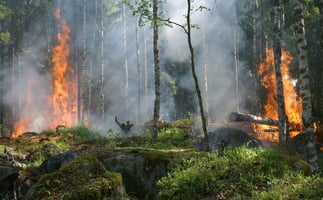Wildfires are a force of nature that can ruin the lives, land, and structures that stand in their...
ISO Building Construction Classes and Commercial Property Insurance
When it comes to commercial property insurance, one of the most critical—and often overlooked—factors is the building construction class. Insurance underwriters assess a structure's insurability using a framework known as COPE: Construction, Occupancy, Protection, and Exposure. Among these, construction classification plays a significant role in determining insurance premiums, coverage availability, and the overall risk profile.
This comprehensive guide explores the six ISO building construction classes and how each classification impacts commercial insurance, safety, and operational efficiency. Understanding these categories helps business owners make smarter building decisions while controlling long-term insurance costs.
What Are ISO Construction Classes?
The Insurance Services Office (ISO) categorizes commercial buildings into six primary construction classes based on materials used in the walls, roofs, and support systems. These classifications are ranked based on their fire and wind resistance, which directly impact insurance rates.
ISO Class 1 – Frame Construction
Definition:
Frame buildings feature wooden or lightweight metal structural elements, including wood-framed exterior walls and wood-supported roofs. While exterior finishes may include siding, brick veneer, or metal, the internal structure is the key identifier.
Common Occupancies:
- Small offices
- Motels
- Apartment buildings (4 stories or less)
- Temporary warehouse structures
How to Identify:
Look for wooden studs behind wall finishes or gabled roofs with combustible shingles. Brick veneers often confuse the classification—check the structural framing underneath.
Pros:
- Cost-effective
- Quick and simple to construct
- Easily modified or expanded
Cons:
- Limited height and size
- High susceptibility to fire and wind damage
- Elevated insurance premiums
ISO Class 2 – Joisted Masonry Construction
Definition:
These buildings use masonry exterior walls (e.g., brick, concrete, stone) with wooden or combustible floor and roof systems. Fire-resistance ratings typically reach at least one hour.
Common Occupancies:
- Retail stores
- Office complexes
- Small warehouses
- Apartment buildings
How to Identify:
Inspect the underside of roofs—a wood-decked roof suggests joisted masonry. Also, verify the structure isn't steel-reinforced; otherwise, it may fall into a higher classification.
Pros:
- Better fire resistance than frame buildings
- Stronger structural stability
- Often salvageable post-incident
Cons:
- Wood components are still prone to fire damage
- Not ideal for high-risk fire environments
ISO Class 3 – Noncombustible Construction
Definition:
Noncombustible buildings feature metal or steel exterior walls and roofs, and structural components are made from noncombustible materials, reducing fire risk significantly.
Common Occupancies:
- Light industrial facilities
- Distribution centers
- Storage warehouses
How to Identify:
The presence of a steel skeleton inside the building is the defining factor. Metal walls or roofs alone don’t guarantee this class—check for internal noncombustible supports.
Pros:
- Greater fire resistance
- Simple to construct and maintain
Cons:
- Fire can still weaken steel framing
- May require fire-resistant insulation for better protection
ISO Class 4 – Masonry Noncombustible Construction
Definition:
This class includes buildings with masonry exterior walls (such as concrete block or tilt-up walls) and noncombustible floors and roofs, typically made from steel or concrete.
Common Occupancies:
- Strip malls
- Manufacturing facilities
- Commercial warehouses
How to Identify:
Focus on the roof and floor composition. If they’re made from steel or concrete, and the walls are masonry, you’re likely looking at a masonry noncombustible structure.
Pros:
- More fire-stable than noncombustible steel buildings
- Longer lifespan in industrial settings
Cons:
- Unprotected steel may degrade over time
- Identification can be challenging without blueprints
ISO Class 5 – Modified Fire Resistive Construction
Definition:
These buildings use fire-protected steel framing and offer between one and two hours of fire resistance. Materials such as concrete, gypsum block, or plaster are used to shield structural components.
Common Occupancies:
- Mid-rise and high-rise office buildings
- Large apartment complexes
How to Identify:
Look for protected steel beams within the wall systems. A detailed inspection or construction plan may be needed for accurate classification.
Pros:
- Can be built taller than ISO 1–4
- Superior fire resistance
Cons:
- More expensive to construct
- Less fire and wind protection than ISO 6
ISO Class 6 – Fire Resistive Construction
Definition:
The highest fire-resistant classification, ISO 6 buildings include reinforced concrete frames and structural components that can withstand fires for a minimum of two hours.
Common Occupancies:
- High-rise buildings
- Parking garages
- Critical infrastructure facilities
How to Identify:
Check for thick concrete walls (4+ inches) or masonry walls at least 12 inches thick. Roofs and floors are reinforced and noncombustible. Identification often requires reviewing construction documents.
Pros:
- Exceptional fire and wind resistance
- Allows maximum building height
- Longest structural lifespan
Cons:
- Most expensive to build
- Not common in smaller commercial developments
What About Mixed Construction Classes?
Not every commercial structure fits neatly into one ISO category. Mixed construction classes occur when a building combines different materials due to renovations or expansions. In such cases, insurers classify the building using the lowest-performing component.
The “Two-Thirds Rule”
If 66.67% or more of a specific building component (e.g., exterior walls or roof) is of higher-quality construction, the structure may be rated using the superior class.
For example:
- A building with 75% ISO 4 characteristics and 25% combustible exterior walls may still be rated as ISO 4.
- A warehouse expansion using frame construction may downgrade the entire structure to ISO 1, even if the original structure is ISO 3 or 4.
Why Construction Class Matters for Insurance and Safety
Choosing the right construction class isn't just about initial build costs—it’s about long-term savings, lower insurance premiums, and improved resilience against fire and wind hazards.
Here’s why business owners should care:- Lower-risk buildings receive better insurance rates
- High-resistance structures reduce downtime after disasters
- Code compliance may prevent certain construction types based on occupancy
In urban areas, building codes typically restrict adding low-class structures to high-occupancy buildings. However, in rural areas, these restrictions may not exist, increasing risks for insurers and property owners.
Balancing Cost and Risk in Commercial Building Design
Understanding ISO construction classes empowers business owners to make informed decisions that affect not only insurance costs but also the safety and longevity of their property. While lower-class structures may be cheaper up front, their long-term costs in terms of insurance premiums, regulatory limitations, and fire risk can far outweigh initial savings.
Whether you're designing a new facility or evaluating an existing one for insurance purposes, knowing your construction classification is essential to protecting your business investment.
Contact a TPG Commercial Insurance Expert for more information at 909.466.7876 today! Also, check out the Comprehensive Insurance Guide for Gasoline Stations and Why Business Interruption Insurance Is Essential for Small Businesses.




